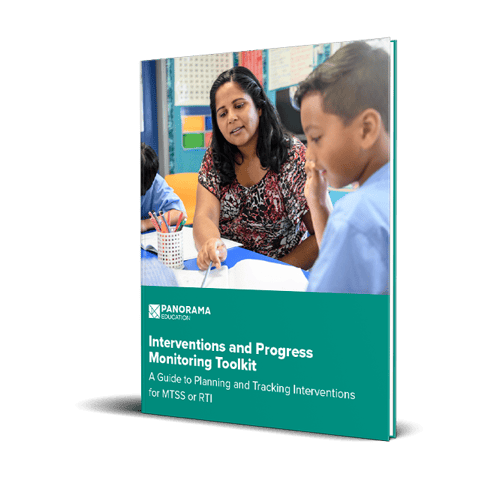Dr. Rexanne Hill has 25 years of experience in schools, with roles ranging from classroom teacher to building and district administrator. Most recently, she served as Executive Director of Student Support at Lee's Summit R-7 School District, where she led the district-wide implementation of Panorama Student Success and Panorama Surveys. Today, she brings her expertise to Panorama as an Education Advisor.
We don’t fix kids. We fix our systems.
That’s the guiding principle at the heart of our work as educators. In my experience as a district administrator, I’ve found that when we have solid systems in place, our students thrive.
However, setting up—or aligning—these systems within your school or district can be a real challenge. Many school districts feel like they have to choose between professional learning communities (PLCs) or a multi-tiered system of supports (MTSS) when it comes to guiding frameworks for student success. But PLCs and MTSS don’t have to be separate processes. In fact, PLCs and MTSS can work together to improve student outcomes across a district.
What is a PLC?
A PLC is how adults in your building do business. It's a group of educators who meet regularly to discuss student achievement and examine data and results.
PLCs have the following five common characteristics:
- Shared commitment to improving student learning and outcomes
- Collective inquiry, collaboration, and shared practice
- Supportive and shared leadership by all members: administrators and teachers
- Supportive conditions for collaboration, including designated meeting times and a well-developed communication structure
- An orientation toward action
How PLCs Fit Into MTSS
Whether your district has a strong PLC process in place or you’re just getting started, it’s important to consider how PLCs can fit into your district’s MTSS. MTSS is a tiered framework for supporting all students across academics, social-emotional learning, attendance, and behavior by providing targeted interventions across three levels of support.
As you dig in, you’ll find that both systems operate under similar conditions. Both PLCs and MTSS involve data-driven decision making. Both involve processes to identify and help students who need extra support. And, most importantly, both keep student success at the heart of their processes.
But the difference is that PLCs are a powerful cog in the greater MTSS machine. PLCs are the practices that adults operate within to carry out MTSS processes—and a strong PLC process can form the core of your district’s MTSS.
Why Integrate PLCs Into Your MTSS
By incorporating the learning, decision-making processes, and evaluations done within PLCs into your MTSS framework, your district can strengthen its approach to:
- Collecting and acting on data
- Collaborating with colleagues
- Developing systems of progress monitoring and intervention planning
Educators and administrators can leverage the work done in PLCs to ensure no students are slipping through the cracks. That's because, ultimately, both PLCs and MTSS are action-oriented. These teams don’t just examine data—they use data as the catalyst for action and continuous improvement.
How the 4 Questions of PLCs Support an MTSS Framework
Educator and researcher Richard DuFour developed four questions to anchor the structure of a PLC, which are amplified through an MTSS framework.
1. What do we want all students to know and be able to do?
One of the “big ideas” of a PLC is a focus on learning, ensuring that all students learn at a high level. In order to achieve that, PLCs leverage the collective knowledge and experience of the school community. Similarly, MTSS aligns the entire system of supports and resources within a school district.
Questions to ask:
- Have we defined our essential standards?
- How have we developed our Portrait of a Graduate?
- What will our graduates know and be able to do?
2. How will we know if they learn it?
A major goal of PLCs is to gather evidence of student learning. An MTSS-driven approach to progress monitoring can align with your PLC's collective inquiry into student learning.
Questions to ask:
- Do we have a system for regularly (at least every 3-4 weeks) monitoring the progress of all students, including the individual goals for students at Tier 3?
- Do our teachers use both formative and summative data to adjust or differentiate instruction?
3. How will we respond when some students do not learn?
Educators can leverage the shared inquiry and data collection done in PLCs to develop targeted interventions for students within an MTSS.
Questions to ask:
- Do we have teams that meet, review data, problem solve, and adjust instruction and interventions based on data on a regular basis?
- Are interventions designed to address the skills needed to master essential standards?
- Do we have a method for students to exit interventions as soon as goals are mastered rather than being locked into an intervention for a predetermined period of time?
4. How will we extend the learning for students who are already proficient?
MTSS is for all students, including those who thrive for enrichment in a certain subject. PLCs can help to identify these students and use data to determine where—and when—they require additional supports.
Questions to ask:
- Do we use pre-assessments to determine skill gaps as well as identify students who need extension on the particular standard being taught?
- Do we presume that only identified advanced learners need extension?
- Do we understand that by using pre-assessment, we will identify any student who may be advanced in a particular skill or standard?
Creating a Strong Foundation: Next Steps for Schools and Districts
We’ve seen a lot of change in our schools and districts over the past few years: the COVID-19 pandemic, teacher and staff shortages, declines in math and literacy scores, and more. And all that change has presented real challenges for educators.
But if our systems are consistent within that change, then we can rely on our strong foundations to continue to move forward. That’s the power of integrating PLCs into your MTSS.
As you plan professional development for the upcoming semester, focus on ways to share and act on data, and determine how to align PLC work with MTSS goals. To support your team’s work, consider using resources such as:
- MTSS Self-Assessment
- 3 Questions Every Data-Driven MTSS Support Team Must Ask Weekly
- Solving the 5 Biggest Challenges of MTSS
It’s critical to create strong MTSS and PLC frameworks and integrate them. Because when we, as educators, take the time to build out strong, foundational systems of collaboration and continuous improvement, our students see the long-term benefits.







